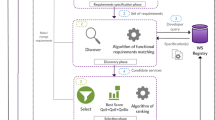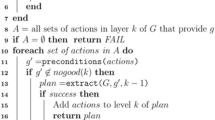Abstract
In software markets of the future, customer-specific software will be developed on demand based on distributed software and hardware services. Based on a customer-specific request, available service offers have to be discovered and composed into sophisticated IT services that fulfill the customer’s request. A prerequisite of this vision are rich service descriptions, which comprise structural as well as behavioral aspects of the services, otherwise an accurate service discovery and composition is not possible. However, automatic matching of service requests and offers specified in rich service descriptions for the purpose of service discovery is a complex task, due to the multifaceted heterogeneity of the service partners. This heterogeneity includes the use of different specification languages, different underlying ontologies, or different levels of granularity in the specification itself. In this article, we present a comprehensive approach for service discovery and composition, which overcomes the underlying heterogeneity of the service partners. Based on a realistic case study of our industrial partner from the e-tourism domain, we first introduce an automatic matching mechanism for service requests and offers specified in a rich service description language. In addition, we propose an automatic service composition approach, which determines possible service compositions by composing the service protocols through a composition strategy based on labeled transition systems.

























Similar content being viewed by others
Notes
Please note that before operations in service offers and requests are matched, suitable service offers may be preselected based on a domain-specific categorization provided by the service market. However, this pre-selection is out of scope in our approach.
Please note that before operations in service offers and requests are matched, suitable service offers may be preselected based on a domain-specific categorization provided by the service market. However, this preselection is out of scope in our approach.
References
W3C (2007) Web Service Description Language (WSDL). http://www.w3.org/TR/wsdl20/
Studer R, Benjamins VR, Fensel D (1998) Knowledge engineering: principles and methods. Data Knowl Eng 25(1–2):161–197
Haller A, Cimpian E, Mocan A, Oren E, Bussler C (2005) WSMX—a semantic service-oriented architecture. In: IEEE international conference on web services (ICWS’05). IEEE Computer Society, pp 321–328
LSDIS Lab (2004) Web service semantics. http://lsdis.cs.uga.edu/projects/WSDL-S/wsdl-s.pdf
OWL-S Coalition (2006) OWL-based web service ontology. http://www.ai.sri.com/daml/services/owl-s/1.2/
Huma Z, Gerth C, Engels G, Juwig O (2012b) UML-based rich service description and discovery in heterogeneous domains. In: Proceedings of the forum at the CAiSE’12 conference on advanced information systems engineering, CEUR-WS.org, CEUR workshop proceedings, vol 855, pp 90–97
Huma Z, Gerth C, Engels G, Juwig O (2012a) Towards an automatic service discovery for UML-based rich service descriptions. In: Proceedings of the 15th international conference on model driven engineering languages and systems (MODELS’12), LNCS, vol 7590. Springer, Berlin, pp 709–725
Huma Z, Gerth C, Engels G, Juwig O (2013) Automated service discovery and composition for On-the-Fly SOAs. Tech. Rep. TR-RI-13-333, University of Paderborn, Germany. http://is.uni-paderborn.de/uploads/tx_sibibtex/tr-ri-13-333.pdf
Object Management Group (OMG) (2009) Unified modeling language (UML)—superstructure, version 2.3. http://www.omg.org/spec/UML/2.3/Infrastructure
de Bruijn J, Lausen H, Polleres A, Fensel D (2006) The web service modeling language WSML: an overview. In: Sure Y, Domingue J (eds) ESWC, LNCS, vol 4011. Springer, Berlin, pp 590–604
Lohmann M (2006) Kontraktbasierte Modellierung, Implementierung und Suche von Komponenten in serviceorientierten Architekturen. PhD thesis, University of Paderborn
Noy NF (2004) Semantic integration: a survey of ontology-based approaches. SIGMOD Record 33:65–70
Miller GA (1995) WordNet: a lexical database for English. Commun ACM 38(11):39–41
Mendes PN, Jakob M, Bizer C (2012) DBpedia for NLP: a multilingual cross-domain knowledge base. In: Proceedings of the eight international conference on language resources and evaluation (LREC’12), Istanbul
Schwichtenberg S (2013) Ontology-based normalization and matching of rich service descriptions. Master’s thesis, University of Paderborn
Euzenat J, Shvaiko P (2007) Ontology matching, vol 18. Springer, Berlin
Shvaiko P, Euzenat J (2013) Ontology matching: state of the art and future challenges. IEEE Trans Knowl Data Eng 25(1):158–176
European Bioinformatics Institute (2011) Experimental Factor Ontology Tools. http://www.ebi.ac.uk/efo/tools
Hausmann JH, Heckel R, Lohmann M (2005) Model-based development of web service descriptions enabling a precise matching concept. Int J Web Services Res 2(2):67–85
Bernardi S, Donatelli S, Merseguer J (2002) From UML sequence diagrams and statecharts to analysable petri net models. In: Proceedings of the 3rd international workshop on software and performance. ACM, pp 35–45
Hausmann JH (2005) Dynamic meta modeling: a semantics description technique for visual modeling languages. PhD thesis, University of Paderborn
Küster JM, Stehr J (2003) Towards explicit behavioral consistency concepts in the UML. In: Proceedings of the 2nd international workshop on scenarios and state machines: models, algorithms and tools, Portland
DeMarco T (1979) Structured analysis and system specification. Prentice Hall PTR
Cicalese CDT, Rotenstreich S (1999) Behavioral specification of distributed software component interfaces. IEEE Comput 32(7):46–53. http://dblp.uni-trier.de/db/journals/computer/computer32.html#CicaleseR99
D’Souza DF, Wills AC (1998) Objects, Components, and Frameworks with UML: The Catalysis Approach. Addison-Wesley Professional, Addison-Wesley Object Technology Series
Glinz M (2007) On non-functional requirements. In: Proceedings of 15th IEEE international requirements engineering conference (RE ’07), pp 21–26
Tsui F, Karam O (2010) Essentials of software engineering. Jones & Bartlett Learning
Sabou M, Richards D, van Splunter S (2003) An experience report on using DAML-S
Atkinson C, Bostan P, Brenner D, Falcone G, Gutheil M, Hummel O, Juhasz M, Stoll D (2008) Modeling components and component-based systems in kobra. In: Rausch A, Reussner R, Mirandola R, Plasil F (eds) The common component modeling example, LNCS, vol 5153. Springer, Berlin, pp 54–84
Becker S, Brogi A, Gorton I, Overhage S, Romanovsky A, Tivoli M (2006) Towards an engineering approach to component adaptation. In: Reussner RH, Stafford JA, Szyperski CA (eds) Architecting systems with trustworthy components, LNCS, vol 3938. Springer, Berlin, pp 193–215
Brown AW, Wdlnau KC (1996) Engineering of component-based systems. In: Proceedings of 2nd IEEE international conference on engineering of complex computer systems (ICECCS’96), pp 414–422
Mätzel KU, Schnorf P (1997) Dynamic component adaptation. Tech. rep., Ubilab Technical Report 97.6
Allen R, Garlan D (1997) A formal basis for architectural connection. ACM Trans Softw Eng Methodol 6(3):213–249
Schmidt HW, Reussner RH (2002) Generating adapters for concurrent component protocol synchronisation. In: Proceedings of the IFIP TC6/WG6.1 5th international conference on formal methods for open object-based distributed systems V (FMOODS’02). Kluwer, B.V., Deventer, pp 213–229
Yellin DM, Strom RE (1997) Protocol specifications and component adaptors. ACM Trans Program Lang Syst 19(2):292–333
Küster J, Stroop J (2001) Consistent design of embedded real-time systems with UML-RT. In: Proceedings of fourth IEEE international symposium on object-oriented real-time distributed computing. IEEE Computer Society, pp 31–40
Moffett Y, Beaulieu A, Dingel J (2011) Verifying UML-RT protocol conformance using model checking. In: Proceedings of 14th international conference on model driven engineering languages and systems (MODELS’11), LNCS, vol 6981. Springer, Berlin, pp 410–424
Shigo O, Okawa A, Kato D (2006) Constructing behavioral state machine using interface protocol specification. In: Proceedings of the XIII Asia Pacific software engineering conference (APSEC’06). IEEE Computer Society, pp 191–198
Both A, Zimmermann W (2008) Automatic protocol conformance checking of recursive and parallel BPEL systems. In: Proceedings of the 2008 sixth European conference on web services (ECOWS’08). IEEE Computer Society, pp 81–91
Cavallaro L, Nitto E, Pradella M (2009) An automatic approach to enable replacement of conversational services. In: Baresi L, Chi CH, Suzuki J (eds) ICSOC-ServiceWave ’09. LNCS, vol 5900. Springer, Berlin, pp 159–174
Motahari Nezhad HR, Benatallah B, Martens A, Curbera F, Casati F (2007) Semi-automated adaptation of service interactions. In: Proceedings of the 16th international conference on world wide web (WWW’07). ACM, pp 993–1002
Pathak J, Basu S, Honavar V (2006b) Modeling web services by iterative reformulation of functional and non-functional requirements. In: Proceedings of the 4th international conference on service-oriented computing (ICSOC’06), LNCS, vol 4294. Springer, Berlin, pp 314–326
Poizat RMP, Salaün G (2008) Adaptation of service protocols using process algebra and On-the-Fly reduction techniques. In: Bouguettaya A, Krüger I, Margaria T (eds) Proceedings of international conference on service oriented computings (ICSOC’08), LNCS, vol 5364. Springer, Berlin, pp 84–99
Spanoudaki G, Zisman A (2010) Discovering services during service-based system design using UML. IEEE Trans Softw Eng 36(3):371–389
Mukhija A, Rosenblum DS, Dingwall-Smith A (2007) Dino: dynamic and adaptive composition of autonomous services. Department of Computer Science, University College London, London, White paper
Klusch M, Kaufer F (2009) WSMO-MX: a hybrid semantic web service matchmaker. Web Intell Agent Syst 7:23–42
Rao J, Su X (2004) A survey of automated web service composition methods. In: Proceedings of the first international conference on semantic web services and web process composition (SWSWPC’04), vol 3387. Springer, Berlin, pp 43–54
Bartalos P, Bieliková M (2011) Automatic dynamic web service composition: a survey and problem formalization. Comput Inf 30(4):793–827
Essi, WSMO Working Group (2005) Web Service Modelling Ontology. http://www.wsmo.org/
Aggarwal R, Verma K, Miller JA, Milnor W (2004) Constraint driven web service composition in METEOR-S. In: IEEE International conference on services computing (SCC’04). IEEE Computer Society, pp 23–30
Bartalos P, Bieliková M (2010) QoS aware semantic web service composition approach considering pre/postconditions. In: Proceedings of IEEE international conference on web services (ICWS’10). IEEE Computer Society, pp 345–352
Brogi A, Corfini S, Popescu R (2008) Semantics-based composition-oriented discovery of web services. ACM Trans Internet Technol 8(4):19:1–19:39
Kona S, Bansal A, Blake MB, Gupta G (2008) Generalized semantics-based service composition. In: IEEE international conference on web services (ICWS’08). IEEE Computer Society, pp 219–227
Naeem M, Heckel R, Orejas F, Hermann F (2010) Incremental service composition based on partial matching of visual contracts. In: Proceedings of fundamental approaches to software engineering (FASE’10), LNCS, vol 6013. Springer, Berlin, pp 123–138
Pathak J, Basu S, Honavar V (2006a) Modeling web service composition using symbolic transition systems. In: Proceedings of AAAI workshop on AI-driven technologies for service-oriented computing. AAAI Press, California
Patil AA, Oundhakar SA, Sheth AP, Verma K (2004) Meteor-s web service annotation framework. In: Proceedings of the 13th international conference on world wide web (WWW’04). ACM, pp 553–562
Vaculin R, Neruda R, Sycara K (2009) The process mediation framework for semantic web services. Int J Agent Oriented Softw Eng 3(1):27–58
Author information
Authors and Affiliations
Corresponding author
Additional information
This work was partially supported by the German Research Foundation (DFG) within the Collaborative Research Centre “On-The-Fly computing” (SFB 901).
Rights and permissions
About this article
Cite this article
Huma, Z., Gerth, C. & Engels, G. On-The-Fly computing: automatic service discovery and composition in heterogeneous domains. Comput Sci Res Dev 30, 333–361 (2015). https://doi.org/10.1007/s00450-014-0254-z
Published:
Issue Date:
DOI: https://doi.org/10.1007/s00450-014-0254-z





